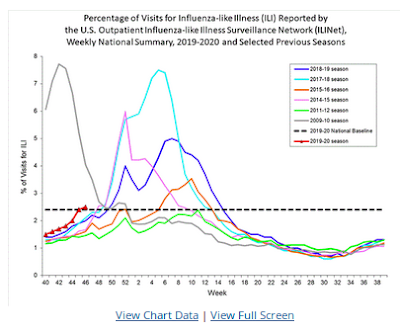#14,541
The CDC has released their weekly FluView Report (Week 46, ending Nov 16th), and it indicates that the levels of influenza-like illnesses (ILIs) have increased, and for the first time during the 2019-2020 flu season (barely) exceed the national baseline level.
This is an earlier start than we've seen in recent years, and perhaps most significantly, occurs before next week's Thanksgiving holidays, where millions of people will travel and enjoy family gatherings.That said, the level of ILI activity varies widely across the country (see map below), with most of the heavy activity currently found in the deep south.
While the mixture of flu subtypes is likely to change over the coming weeks, right now influenza B (Victoria) leads the pack, followed by A/H1N1 and A/H3N2.
This breakdown of flu subtypes by age from this week's FluView.
The predominant virus also varies by age group. Nationally, influenza B/Victoria viruses are the most commonly reported influenza viruses among children age 0-4 years (48% of reported viruses) and 5-24 years (56% of reported viruses), while A(H3N2) viruses are the most commonly reported influenza viruses among persons 65 years of age and older (70% of reported viruses). Among adults aged 25-64 years, approximately equal proportions of influenza A(H1N1)pdm09, A(H3N2) and B/Victoria viruses (33%, 24% and 31%, respectively) have been reported.All of which means it is too soon to even begin to guess how this flu season will play out. The CDC provides the following Key Messages.
While an early start may mean an earlier end to the flu season, it doesn't always work out that way. Last year we saw one of the longest flu seasons (21 weeks) in recent memory, and while it started out fairly mild, by mid-January it morphed into a moderately severe epidemic.
If you haven't gotten a flu shot, today would be a good day to do so.But whether you get the flu shot or not - particularly given the number of non-influenza viruses out there - now is also the time to start consistently practicing good flu hygiene (covering coughs, washing hands, staying home if you are sick, etc.).




